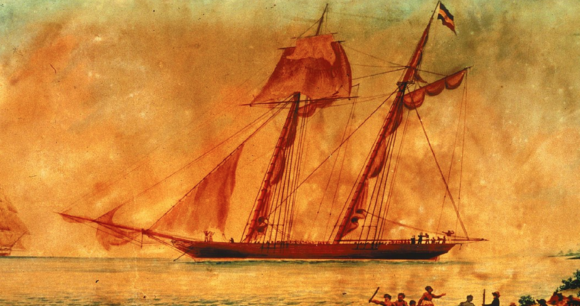The Fantastical Art (and History) of Early Mardi Gras
It’s Mardi Gras season!

Darwin as an ass costume designed by Charles Briton for the “Missing Links” theme, Mistick Krewe of Comus, 1873: Carnival Collection, Louisiana Research Collection, Tulane University — Source.
From The Public Domain Review,
Illustrating Carnival: Remembering the Overlooked Artists Behind Early Mardi Gras
For more than 150 years the city of New Orleans has been known for the theatricality and extravagance of its Mardi Gras celebrations. Allison C. Meier looks at the wonderfully ornate float and costume designs from Carnival’s “Golden Age” and the group of New Orleans artists who created them.
“On March 6, 1889, the New York Times breathlessly reported on the recent Carnival spectacles in New Orleans. The Krewe of Rex’s pageant, themed around “Treasures of the Earth”, included a “Crystal” float “attended by figures in gorgeous costumes and prisms by the thousand”, and a “Diamond” float featuring “a rocky diamond dell” through which flowed “limpid streams where nymphs sported and played with the gems”. The Krewe of Proteus, meanwhile, dazzled with their “Hindoo Heavens” pageant, where in one scene appeared Agni “God of Fire” riding a ram that “strides the flames, attended by the fire sprites.” This opulent, and highly exoticized, interpretation of South Asian religion concluded with a tableau where “Vishnu, under the guise of a horse with silver wings, shatters the earth with his hoof and rises to the celestial abode.”
The modern American Mardi Gras owes much of its bombastic revelry to this late nineteenth-century “Golden Age” of Carnival design. From the invitations to the costumes to the hand fans carried by spectators, artists designed entire identities for each Krewe (a group that organizes a Carnival event). Carnival and its culminating day of festivities — Mardi Gras — was brought to the Louisiana area by the French in the late seventeenth century. Mardi Gras as it’s celebrated today is often linked to the Mistick Krewe of Comus, an Anglo-American group which in 1857 organized a debut parade themed “The Demon Actors in Milton’s Paradise Lost”. It was a departure from previous Carnivals that were more informal and tied to the Roman Catholic community. Following the Civil War, new Krewes emerged, each attempting to outdo the others with increasingly elaborate wood and papier-mâché floats pulled by teams of horses. One year it might be Medieval legends coming to life on the streets, the next flying monkeys of Chinese mythology terrorizing the crowds…”
For all of it (so many amazing illustrations!), click here.
Share


